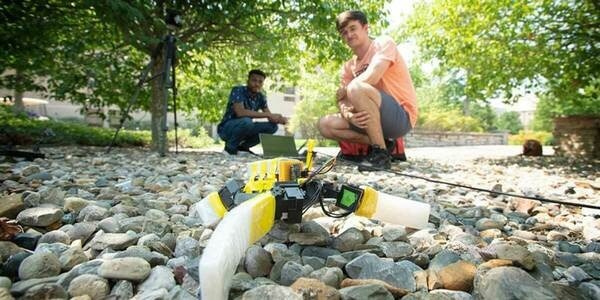Ozkan-Aydin, electrical engineering doctoral student Nnamdi Chikere and undergraduate John Simon McElroy, a Naughton Fellow from University College Dublin, have engineered and constructed a robotic sea turtle, which they are testing in altered environments on Notre Dame’s campus.

Image Credit: University of Notre Dame.
The sea turtle’s unique body shape, the morphology of their flippers, and their varied gait patterns makes them very adaptable.
Yasemin Ozkan-Aydin, Roboticist and Assistant Professor of Electrical Engineering, University of Notre Dame
Ozkan-Aydin added, “Mimicking this adaptability is challenging because it requires an intricate understanding of how morphology, flexibility, and gait interact with the environment. Studying how sea turtles adapt their gaits to traverse complex and varied terrains can help us design more versatile robots.”
Their robot copies a real sea turtle’s propulsion: its front flippers move it ahead while its smaller hind flippers enable it to alter direction.
The main components of their turtle robot are four separately radio-controlled flippers, an oval-shaped body, a multi-sensor device, and a battery and an electronic onboard control unit. With the help of a rigid polymer, the body frame and flipper connectors have been 3D printed. The flippers are molded from silicone to offer both stiffness and flexibility.
The robot was engineered by making use of data from zoological studies on the morphology, gait patterns, and flipper flexibility of several sea turtle species.
To maximize adaptability and versatility, we studied the locomotion patterns of different species and incorporated the most effective aspects from each.
Yasemin Ozkan-Aydin, Roboticist and Assistant Professor of Electrical Engineering, University of Notre Dame
Depending on the size and structure of sea turtle hatchlings, Ozkan-Aydin modeled the robot. Sea turtle babies are especially vulnerable—only one in a thousand make it to adulthood. Hatchlings should run a gauntlet of predator sea birds on their journey from nest to ocean, and that journey has turned out to be highly perilous by a disorienting landscape of beach development and debris.
Our hope is to use these baby sea turtle robots to safely guide sea turtle hatchlings to the ocean and minimize the risks they face during this critical period.
Yasemin Ozkan-Aydin, Roboticist and Assistant Professor of Electrical Engineering, University of Notre Dame
Robotic Sea Turtle
Video Credit: University of Notre Dame.